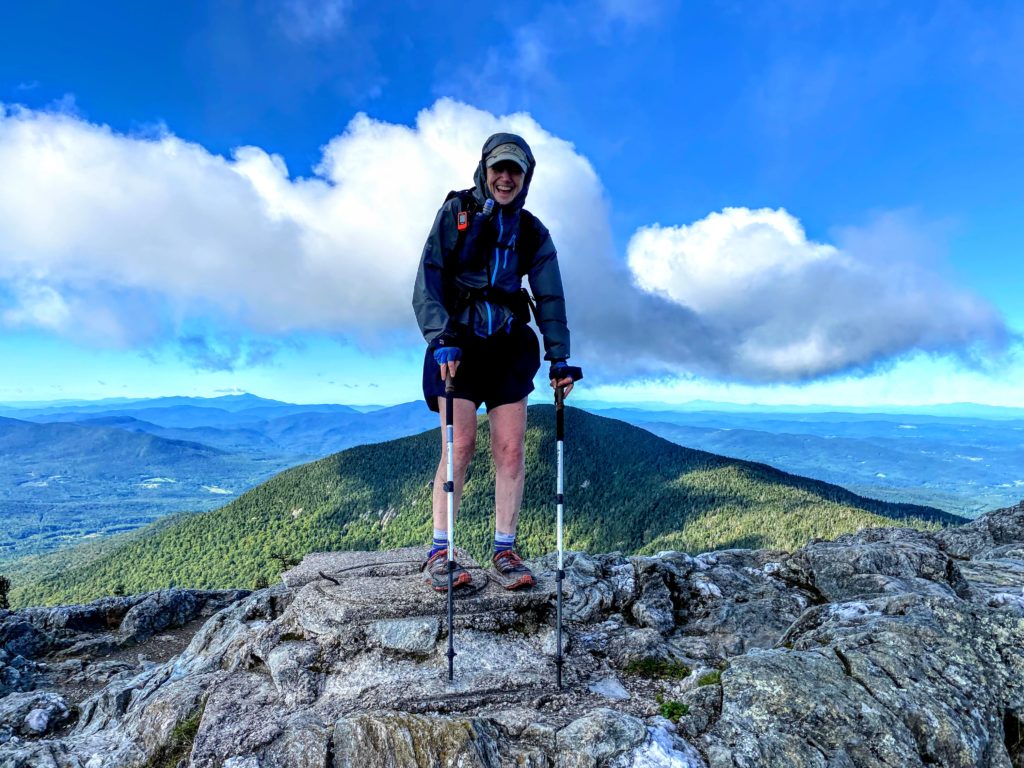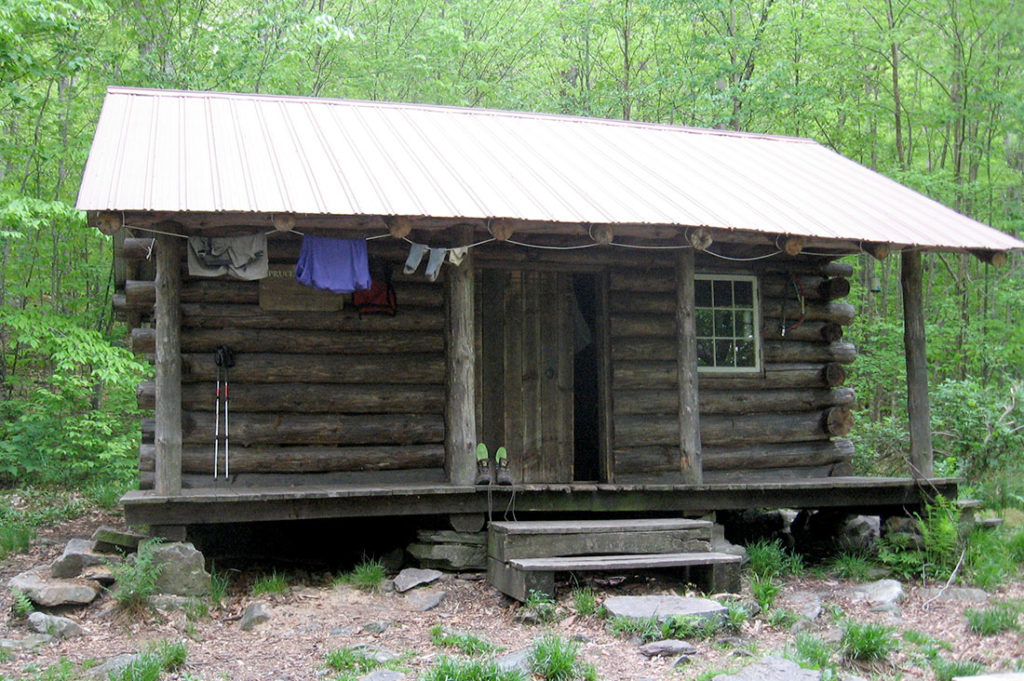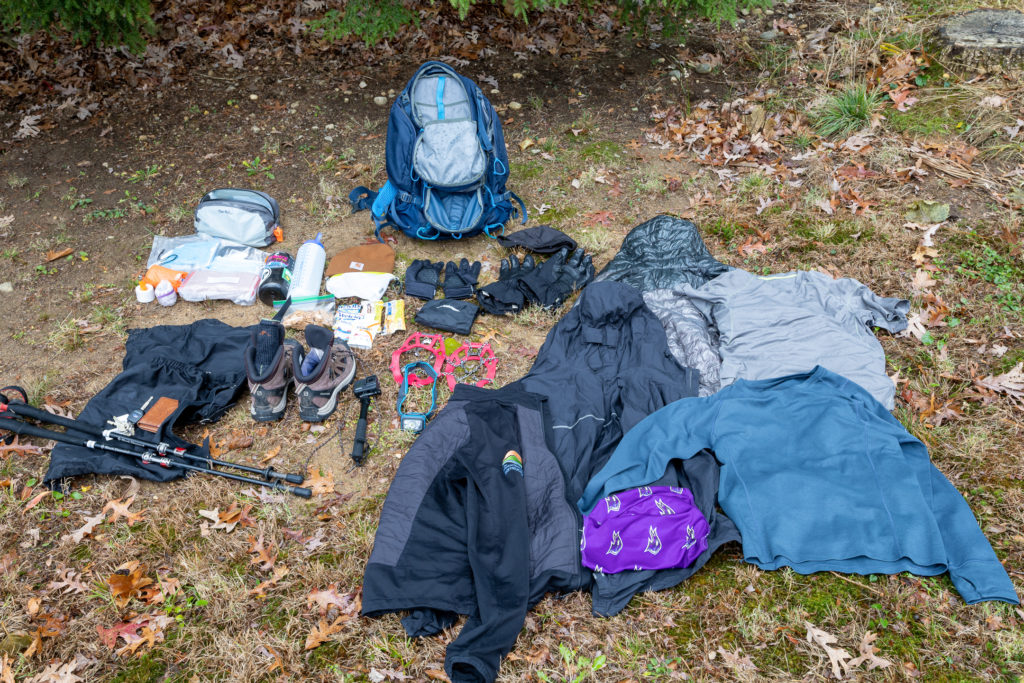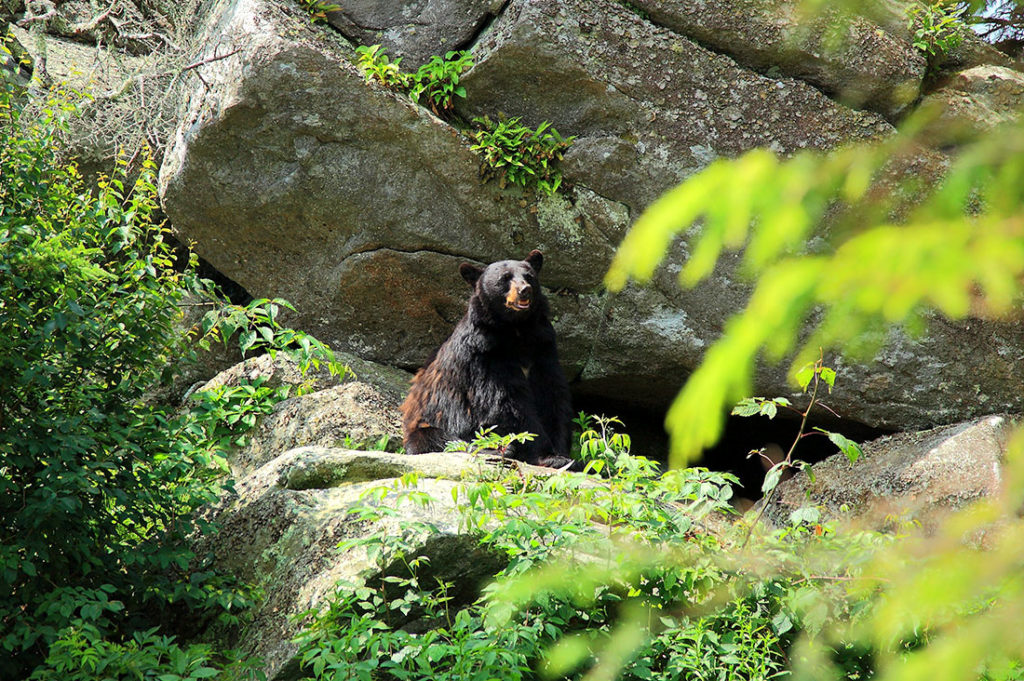Last week, seven end-to-enders took questions from the hiking community about their experiences hiking the Long Trail. Whether you’re simply curious about the Long Trail, or you’re actively planning an end-to-end hike over its 272 miles, browse the attendees’ questions and the answers from panelists and GMC staff.
[Part One of this Q&A covers gear, footwear, food, shelter, wildlife safety, and hiking with dogs. Part two will cover aspects of planning, including technology, training, pacing, transportation needs, solo hiking, and conditions.]

Meet the panelists:
- Joan Butterton (she/her) is an infectious disease doctor who took some time off from treating Covid to solo hike NOBO last August, her first solo backpacking trip.
- George Ma (he/him) completed the Long Trail NOBO last summer at age 18, before his freshman year of college. It was his first thru hike.
- Emily Hunt (she/her) hiked in fall 2020, SOBO. Emily has lots of insight into using public transit and shuttles to plan your hike.
- High schoolers Cassandra (she/her) and Jessica Royer (she/her) hiked last July with mom Jennifer Royer (she/her) and another friend. Cassandra, Jessica, and Jennifer shared their mother-daughter experience as local Vermonters who were supported by friends and family along the way.
- Kat Ruegger (she/they) hiked the Long Trail last year prior to starting the Fall semester of college. The Indianapolis native finished the LT in just over two weeks alongside her partner and their dog, Lego. Learn how they prepared on local trails and shuttled themselves around the trail system.
Of course, these panelists shared recommendations that worked for them, and should serve as a starting point. Training, testing gear, and doing your own research will help you find the best options for you. Happy hiking!
Food & Water
How much water do you recommend carrying at a time? Two liters. There are times where you should have more, which is where a collapsible water bottle can be helpful.
What containers did you bring for water? Smartwater bottles and bladders!
Favorite meals? Ramen Bomb. Make ramen, then drop a packet of mash potatoes in it. Oh my god my mouth is watering thinking about it.
Best ways to keep food cold, if at all possible? Food in the middle of the pack can be kept reasonably cool.
How do you cook the nettle? When I cooked it, I put my dinner (usually lentils, coconut milk powder, and some dehydrated veggies) in my cup and on my stove, then stirred the nettle in at the end. It’s similar to spinach, so it cooks very quickly.
Are there a lot of towns to re supply on the way? There are towns every couple of days, depending on your speed. It is fairly easy to fully resupply in towns!
How many days of food did you pack to play it safe between resupply? It’s a good rule to plan for an extra day. Even if it’s emergency food like bars or something else, always good to have a little extra. Your number of days will depend on how often you want to re-supply.
Gear
What type(s) of water purification do you recommend? I used to use gravity (like Platypus). It works well. In my opinion though, squeeze filters — like the Sawyer Squeeze — are the best. Not the mini Sawyer Squeeze though; get the one bigger then that. I highly recommend.
What capacity backpack would you recommend? Mine was 75L, but some people do 60. Some do a bit more. That’s about the range that works though.
Did you need a bug net on your hammock in September? Mine has a built in bug net so I always have it because the bugs love me! Most people would probably be ok with no net SOBO in September.
Did anyone bring rain pants? (And what month did you hike?) I did not have rain pants. I hiked in August. There was a lot of rain, including a tropical storm. However, I do not think rain pants are necessary, especially if you may want to go ultralight.
I used rain pants on the AT but didn’t bother this time. I have knee high gaiters to keep the rain out of my shoes. Otherwise, you get too hot with the pants, so you sweat more than you would get wet from the rain!
Would anyone recommend hiking poles, or does it not really matter? They all recommend hiking poles!
Hiking pole type/brand? Go to a store and try them out and see how they feel in your hand so you can find what you like!
Bathroom questions: did anyone bring a shovel? A bidet? Privy only? Bringing a trowel is a good idea. You never know when the urge is going to strike. With a good, sharp trowel for Vermont’s rooty and rocky soil you can dig a proper cathole, which is 6-8 inches deep and 2-4 inches in diameter. A proper cathole is important for minimizing impacts to water quality, wildlife and other hikers. Imagine the size of a Nalgene.
Curious what people used for stoves, and if anyone went without one? I used a Jetboil, which I used on the whole AT and LOVE it!
How much did your pack weigh? Mine was about 34 pounds to start, including 2L water and food for six days.
Feet & Footwear
Did anyone hike in sandals? Doesn’t sound like it! I wouldn’t suggest. There are a lot of rocks on the Long Trail.
Any issues with wet feet? Socks? Wet feet are always an issue. Socks can be a luxury item, and you’ll want shoes that drain well. Hang your socks on your bag during the day to dry.
You mentioned a liner sock and I’d love to hear it again! They are called Injinji.
Bears & Food Storage
What is the best method for bear proof food storage? The best is a hard-sided bear canister. They are very user-friendly with little opportunity for user error. They’re durable, can hold 5-7 days of food and can be easily cleaned. And you can use them to sit on, use as a footrest or whatever other clever use you can come up with.
If you have a bear canister, where do you put it overnight? Sleep with it 100 yards from your tent, privy, shelter, or water source. Make sure it’s closed, and stick it nested within a tree, under a log or in some branches. You don’t want it near a cliff, water source, or anywhere the bear could roll it around.
If you are using one of the provided bear boxes, does it need to be locked with a padlock? No, you don’t need to bring a padlock. The provided bear box design has a locking mechanism on it. (List of bear boxes on the Long Trail.)
How hard is it to find a tree for a proper bear hang on the LT? It’s hard in my opinion! The high elevation tenting spots don’t have many solid branches. And after a long and tiring day of hiking searching for good trees is exhausting. That’s why we suggest a bear canister or an Ursack.
Please talk about how effective you found the bear bag, specifically where did you put it at night? Did you have any problems with animals chewing through the Ursacks? Hanging a bear bag is hard on the Long Trail. Many trees are at high elevation and too weak for a good bear hang. That is why we suggest a bear canister or Ursack.
Is it enough to secure an Ursack to a tree rather than doing a full bear hang? Yes.
Wildlife & Safety
Did you have any issues with ticks, and if so, what did you do in terms of tick prevention? Not too many honestly. Just check every night and spray bug spray if you really want to be cautious. I don’t think I had to deal with a single tick though. More tick safety tips here.
Did folks spray their clothing with permethrin before heading on the trail to avoid ticks? Did not have too many problems at all with it. But if you used permethrin, you will totally be fine!
Shelters

Be honest, how are the spiders in the shelters? There are not many spiders in the shelters!
How much are the fees at shelters? Fees are $5 at the shelters which have caretakers. You can email [email protected] to find out which shelters have caretakers.
Which shelter would you highly recommend, and why? I’m looking for the best views! Puffer is awesome. Spruce and Butler too! Also at the top of Abraham are some sweet campsites that are not on Guthook Guides.
Dogs
Are dogs allowed on the trail? Yes, dogs are allowed on the trail. There are sections of the trail which are very rugged, so your dog should be in good shape. Also, you should be prepared for your dog to be around wildlife and other people. And there are places where you should leash your dog. More info about hiking the LT with dogs here.
How did Lego, Kat’s dog, get down “Ladder Ravine?” A mixture of her scrambling and us passing her down using the handle on her backpack — imagine holding a suitcase with legs.





















Regarding sandals: I thru-hiked the AT in 2010 in Chacos. It’s doable, and it prevents wet sock problems. In related news, I did not use poles in more rugged terrain. My brain doesn’t work fast enough to put both my feet and my poles in good spots at the same time. No poles in turn strongly suggests a lighter pack.
Up sides:
– Your feet don’t stew in the same water day in and day out.
– Chacos are pretty rugged; I went through two pairs. You might get the same mileage out of traditional boots, but you’d be unlikely to do so in, say, trail runners.
– Stream crossing? No problem. Wade on in. Enjoy the grip. They’ll be dry in 15 minutes.
Down sides:
– Cascading gear requirements (for me anyway). Sandals -> no poles -> lighter pack.
– Your feet may rub differently. I get blisters between my toes, which is a place I’ve never had blisters in boots/shoes. I find taping my rubbing toes together with white athletic tape prevents this until my feet toughen up.
– Until your feet toughen up (a couple of weeks) wet weather can lead to the straps chafing your feet. Wet straps pick up trail grit, which will saw into your soft, moist skin. In time the wear spots toughen up.
– Beware exposed roots hiding beneath vegetation. Catching a toe is unpleasant.
– If you’re a camp shoes sort of person, you’ll still want camp shoes. Comfy though they may be, a change is remains welcome at the end of the day.
Toughening your feet up can be mostly done ahead of time, but probably not fully. In practice, most problems on the trail can be solved by loosening the straps. On the balance, I find Chacos to be a great shoe for a thru-hike.
Like any major gear change, shake it down before a thru-hike. I did a week on Isle Royale and a year of climbing weekends in sandals before I took them on a thru-hike.